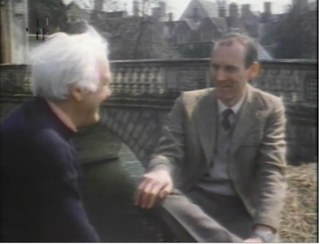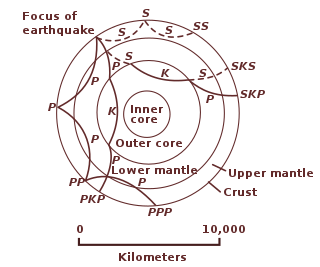Related Research Articles

Geophysics is a subject of natural science concerned with the physical processes and physical properties of the Earth and its surrounding space environment, and the use of quantitative methods for their analysis. Geophysicists, who usually study geophysics, physics, or one of the earth sciences at the graduate level, complete investigations across a wide range of scientific disciplines. The term geophysics classically refers to solid earth applications: Earth's shape; its gravitational, magnetic fields, and electromagnetic fields ; its internal structure and composition; its dynamics and their surface expression in plate tectonics, the generation of magmas, volcanism and rock formation. However, modern geophysics organizations and pure scientists use a broader definition that includes the water cycle including snow and ice; fluid dynamics of the oceans and the atmosphere; electricity and magnetism in the ionosphere and magnetosphere and solar-terrestrial physics; and analogous problems associated with the Moon and other planets.

Marion King Hubbert was an American geologist and geophysicist. He worked at the Shell research lab in Houston, Texas. He made several important contributions to geology, geophysics, and petroleum geology, most notably the Hubbert curve and Hubbert peak theory, with important political ramifications. He was often referred to as "M. King Hubbert" or "King Hubbert".

Frederick John Vine FRS is an English marine geologist and geophysicist. He made key contributions to the theory of plate tectonics, helping to show that the seafloor spreads from mid-ocean ridges with a symmetrical pattern of magnetic reversals in the basalt rocks on either side.
Keith Edward Bullen FAA FRS was a New Zealand-born mathematician and geophysicist. He is noted for his seismological interpretation of the deep structure of the Earth's mantle and core. He was Professor of Applied Mathematics at the University of Sydney in Australia from 1945 until 1971.

Magnetotellurics (MT) is an electromagnetic geophysical method for inferring the earth's subsurface electrical conductivity from measurements of natural geomagnetic and geoelectric field variation at the Earth's surface.
Sir Edward Crisp Bullard FRS was a British geophysicist who is considered, along with Maurice Ewing, to have founded the discipline of marine geophysics. He developed the theory of the geodynamo, pioneered the use of seismology to study the sea floor, measured geothermal heat flow through the ocean crust, and found new evidence for the theory of continental drift.
Herbert Eric Huppert is a British geophysicist. He has been Professor of Theoretical Geophysics and Foundation Director, Institute of Theoretical Geophysics, at the University of Cambridge, since 1989 and Fellow of King's College, Cambridge, since 1970.
Sabba S. Ștefănescu was a Romanian geophysicist, professor of geophysics, member of the Romanian Academy. He was the cofounder, together with Liviu Constantinescu, of the Romanian school of geophysics.
Philip Christopher England FRS is a British geophysicist and former Chair of Geology at the Department of Earth Sciences, University of Oxford, whose research centres upon the evolution, deformation and metamorphism of mountain ranges and the development of island arcs. He has widely used applied mathematics to model mountain building, proving that they behave as extremely viscous fluids.
Gillian Rose Foulger is a British geologist and academic born in 1952 in Ipswich. Foulger plays a major role in coordinating the global debate in the category of Earth Science, on whether or not deep mantle thermal plumes exist and create “hot spot” volcanism.
(Stanley) Keith Runcorn was a British physicist whose paleomagnetic reconstruction of the relative motions of Europe and America revived the theory of continental drift and was a major contribution to plate tectonics.
Martin Everardus Reyners, Auckland, New Zealand FRSNZ Ph.D., is a New Zealand geophysicist and seismologist. He is a Principal Scientist at the Institute of Geological and Nuclear Sciences, Lower Hutt, and is a specialist in subinduction zones, especially in relation to New Zealand.

The following outline is provided as an overview of and topical guide to geophysics:

Clinton Coleridge Farr was a New Zealand geophysicist, electrical engineer and university professor.
Violet Rosemary Strachan Hutton FInstP FRSE FRAS, known to her peers as Rosemary, was a Scottish geophysicist and pioneer of magnetotellurics. Her research focused on the use of electromagnetic methods to determine the electrical conductivity and structure of the Earth's crust, lithosphere and upper mantle, with a particular focus on the African continent and Scotland. She spent over two decades at the University of Edinburgh School of GeoSciences as a researcher and lecturer and was a Fellow of many societies including the American Geophysical Union and The Royal Society of Edinburgh.
Albert Thomas Price was a British geophysicist.
Rupert Sutherland is a New Zealand geologist and academic specializing in tectonics and geophysics at the Victoria University of Wellington and a principal scientist at GNS Science. Sutherland has been described as "one of New Zealand’s leading earth science researchers" by the Royal Society of New Zealand.
Roger Alan Cooper was a New Zealand paleontologist, known as a leading expert on the fossil zooplankton of the early Paleozoic and the paleobiology of Zealandia.
Susan Marian Ellis is a geophysicist based in New Zealand, who specialises in modelling the geodynamics of the Earth's crust deformation, at different scales. Ellis is a principal scientist at GNS Science and her main interests are in subduction, seismology, tectonics, crust and petrology. Ellis's current work focuses on the influence of faulting on stresses in the crust, and how this is related to geological hazard and the tectonic settings in New Zealand.
References
- 1 2 3 "Hugh Bibby". GNS Science. Retrieved 27 January 2022.
- 1 2 3 White, Sue; Bibby, Geoff. "The Bibby Family in New Zealand" (PDF). p. 16. Retrieved 28 January 2022.
- ↑ "New dental director". The Press. Vol. 92, no. 27779. 3 October 1955. p. 10. Retrieved 28 January 2022.
- 1 2 3 4 "Accolade for top geophysicist". GNS Science. Retrieved 27 January 2022.
- ↑ "Previous recipients". Royal Society of NZ. Retrieved 27 January 2022.
- ↑ "New Zealand Geophysics Prize". Geoscience Society of New Zealand. Retrieved 27 January 2022.
- ↑ "List of all Fellows with surnames A–C". Royal Society Te Apārangi. Retrieved 28 January 2022.